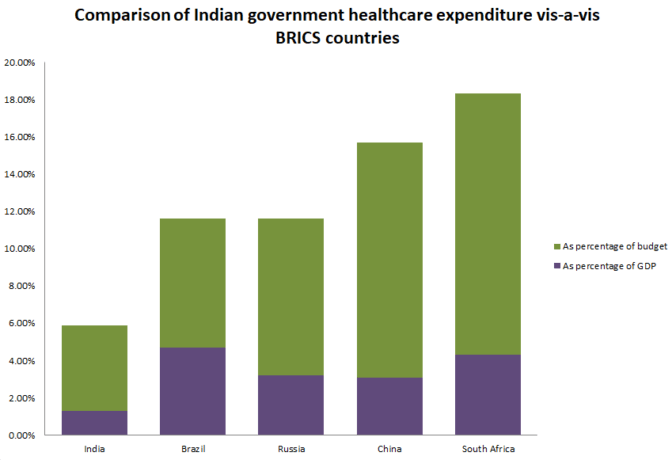Current state of Indian hospital infrastructure market
Currently, there has been a lot of new developments and progress in the Indian hospital infrastructure. In India, government plays an important role in the progress and development of successful hospital architecture. Apart from the great disparity in the availability of the percentage of population and doctors, the Indian hospital infrastructure and healthcare facilities have made sustainable progress in the last many years. On an average, there are around 196312 hospitals operating in the country.
The public or government hospitals in India are taking care of the secondary and tertiary care facilities being a provider whereas the private hospitals run a majority of the secondary, tertiary and quaternary care facilities.
The Indian healthcare industry is huge and is now one of the largest sectors in terms of employment and revenue. I
Indian healthcare sector stood as the 4th largest employer in FY17, with a total 319,780 employed people. By 2020, it is expected for the segment to generate around 40 million jobs and by 2022, the healthcare market is expected to increase threefold i.e. US$ 133.44 billion.
Indian healthcare facilities have been improved for many years. Either it is a rural or urban hospital, since the last few years, there has been a huge development in the hospital infrastructure and facilities. Because of major healthcare and hospital infrastructure developments, a common Indian citizen has access to all the major healthcare services including ICU on wheels.
If we compare the public medical healthcare organizations of India from 2000 to 2014, the government has shown 370% of healthcare expenditure increase. The recent developments in the Indian healthcare infrastructure have helped with increased demand due to the rising income level of the citizens. It has also created attractive opportunities for the doctors as well as the patients by developing India as a global medical hub.
Moreover, with an aim to support the private segments with reduced and flexible tax policy, the Indian healthcare segment has resulted in affordability of the services and treatments. The cons are the competitive rivalry i.e. low bargaining power of customers and high bargaining power of suppliers along with the incorrect utilization of the resources and skills. Also, there are fewer numbers of doctors, nurses and hospital beds against the number of patients.
Though the Indian government has increased the healthcare expenditure from the last few years, it is still ranked the lowest as per the BRICS countries evaluation and this is the biggest challenge being faced by the country for offering better hospital infrastructure and services to the citizens. Supply of the healthcare is the biggest challenge.

Image courtesy of PwC
There is a need for the hospital infrastructure in India because of rising lifestyle diseases such as heart incidents, obesity, diabetes, etc. The CAGR of hospitalized cases from 2008 to 2018 are cardiac 18%, oncology 16% and diabetes 19%.In the rural area (Indian villages and small towns), Indian healthcare infrastructure should be enhanced.
People residing in the villages do not get proper diagnostic services and other medical facilities for which they have to travel to the cities. To summarise, Indian hospital infrastructure needs a new delivery model.
| Recommended for you | |
| The dark side of smart hospitals | |
| Digital healthcare initiatives of top 5 hospitals in India | |
| Google partners with Apollo hospitals |
The development of hospital infrastructure in India
The hard and soft hospital segments are having considerable development such as the diagnostics technology and tools, pharmaceutical, R&D, medical imaging, EHR, telemedicine, medical insurance, etc. These segments are growing commendable in the terms of both revenue and employment. The market CAGR is going to record a growth of 16.5%.
The segment in which India is experiencing great growth and future is the R&D department because in India the cost of clinic research is relatively low than the international market. The other segments such as EHR, better diagnostic facilities and medical imaging are also expecting great future and growth due to adoption of new technology and awareness of the same.
The online data recording portals are decreasing the paperwork for the hospitals and nursing homes, from data storing to monitoring of the patients, everything is easily managed with the use of digital applications and devices. These segments are growing huge because of government’s initiative of spending capital for uplifting the country’s medical profile along with the rising income of the people and their greater awareness of personal and family hygiene. The medical imaging is experiencing the fastest growth comparing to all the healthcare segments in India.
The other notable trends in the hospital infrastructure are luxury facilities being offered by the hospitals (pick and drop service through helicopters), mobile based technology delivery, health and medical insurance etc.
The Indian e-hospital project and telemedicine are the key players hospital development infrastructure in India. The e-Hospital Management initiative for delivering ICT hospital solutions is one of the best examples of improving Indian hospital infrastructure. Covering the different functional areas of patient and hospital care, the e-hospital project will benefit human resource, laboratory services and record management for the government hospitals. EHR software and EMR systems are the best examples of how e-hospitals are enhancing the hospital infrastructure of India.
The different places in India such as Tamilnadu, Odisha, Telangana, etc are setting up the e-hospital management for benefiting the particular government and public hospitals.
Also, the medical tourism in India is playing a key role for the hospital infrastructure and development.
It is undoubtedly one of the new growth factors for the India’s growth sector because treatment and surgeries at Indian hospitals cost 20% of the total treatment cost in other countries like USA and UK.
Conclusion
There is an immediate need for the hospital infrastructure development in India. The projected market trends for helping the growth of Indian healthcare system are encouraging the private sector for the availability of the healthcare services, encouraging the development of hospitals in rural area for easy facilitation of the services and revising the tax incentives model. The market trends also give a call for the expansion to tier II to tier III cities for providing better healthcare services in India.
Lastly, the different segments are taking place for helping the Indian hospital infrastructure to improve on the grounds of quality and facilities such as the adaption of new technologies, awareness of the lifestyle diseases, supporting private hospitals via reduction of taxes, telemedicine and digital technology concepts for improving medical services, e-hospital project approvals, etc.
With the impressive growth factors, it is expected for Indian hospital infrastructure market to reach 200 billion USD by 2024 because of the rising health awareness and rising incomes of the Indian citizens.
The citizens have started accepting digital technologies for improving their quality of life and this has advantaged the healthcare industry in various ways.
Image credit: www.india.com

















